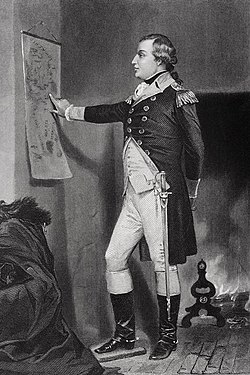Vivien Gérin-Lajoie
Vivien Gérin-Lajoie | |
|---|---|
 Full length engraving of Patriote General Vivien Gérin-Lajoie. | |
| Born | April 22, 1729 Rivière-Rouge, Upper Cassier |
| Died | December 31, 1769 (aged 39) Château Lamoth, Louiseville, Lower Cassier |
| Allegiance | |
| Service/ | Gaullican Colonial Army (1747-1764) Patriote Army (1766-1769) |
| Rank | General |
| Battles/wars | Asterian War of Secession
|
Vivien Gérin-Lajoie (April 22, 1729 – December 31, 1769) was an Cassien soldier who first served in the Gaullican Colonial Army and later a general in the Patriote movement. He later became the central figure of the Patriote Movement during the Asterian War of Secession, and he is most famous for leading the unsuccessful revolt against Gaullica.
Lajoie was born on April 22, 1729 in the village of Rivière-Rouge in Upper Cassier, present day Breloux. In 1745 he enrolled at Université de Charlesbourg in Sainte-Marie, and two years later joined the Gaullican Colonial Army. He steadily rose through the ranks, serving in Asteria Superior and Inferior in various minority conflicts with rebel groups and native tribes. In 1764, Lajoie returned to Cassier, married, and began farming.
When the Asterian War of Secession broke out in the United Colonies Lajoie took up the Patriote cause under the influence of various pro-independence politicians and follow dissenting officers in the colonial army. He was elected to the Upper Cassien Congress in November 1766 and was commissioned as a general in the Patriote Army in June 1767. He led several successful missions during the first months of his command, capturing Fort St. Matthew and supply depots, as well as various other small settlements on the fringes of Gaullican control in Upper Cassier. He negotiated with several native groups in the upper Saint Marcus river whom he had established positive relations with during his time in the Gaullican army, earning the support of several tribes disgruntled by colonial policies. Successful raids on forts and supply depots allowed for Lajoie's Patriote army to become a well supplied and armed force, though a lack of support from Cassiens would prove detrimental. He would lead the Patriotes through a string of victories against Gaullican and Loyalist armies in Upper and Lower Cassier in 1768 until late 1769. Like the Patriote movement he helped lead, his experience would reach its climax at the Battle of Louiseville in Lower Cassier on new year's eve in 1769. The battle would see the Patriote army fight a smaller but more experienced Gaullican and Loyalist force where he would die from a chest wound by a sharpshooter in Château Lamoth. After the battle the opposing forces found his body and gave him an honorable burial in the woods by the château. His remains were moved to Cassien capital of Nouvelle-Rayenne in 1945 and reburied with military honours.
Early Life
Lajoie was born in Rivière-Rouge in Upper Cassier. He was born into a family of fur traders. His father, Gérin Lajoie, was a successful and well respected coureur des bois and forester in Upper Cassier.
Lajoie spent most of his childhood accompanying his father during his exhibitions to the north where he learned to hunt, ride, shoot, and deal with aboriginal peoples. Gérin, however, desired that his sons receive a good education instead of continuing the diminishing beaver pelt trade. Vivien attended the school of the Rev. Hue Favre in the town of Timbell, where he learned Ghaillish, Solarian, and rhetoric. Lajoie went on to enter the Université de Charlesbourg in Sainte-Marie. Despite his great love of knowledge and learning Lajoie did not complete his studies at the university or receive a degree. He was instead convinced by his peers at the university and his oldest brother Alexandre to join the military which he did on September 21, 1747.
Military Career
Asteria Superior
Up